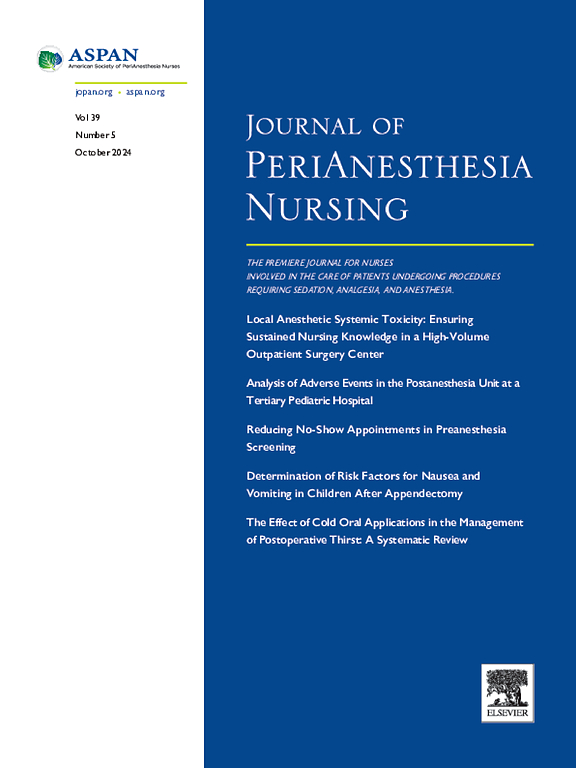Empowering Nurses to Increase Certification Rates in a Postanesthesia Care Unit: A Collaborative Team Approach
IF 1.6
4区 医学
Q2 NURSING
引用次数: 0
Abstract
Purpose
The number of postanesthesia care unit (PACU) registered nurses (RNs) with a specialty nursing certification at an orthopedic hospital in an academic health system was below the organizational benchmark. A clinical nurse-led process was developed to increase the percentage of PACU RNs with a specialty certification. This article will describe the strategies and interventions identified to support, reward, and recognize nurses who obtain or maintain their specialty certifications.
Design
A performance improvement project using the Plan-Do-Study-Act cycle.
Methods
A gap analysis identified barriers preventing PACU nurses from obtaining specialty certifications in an orthopedic acute care American Nurses Credentialing Center Magnet-designated hospital. An anonymous web-based survey was distributed to 18 nurses who, although eligible, were not certified. The survey assessed common barriers to certification (eg, cost of the examination, comfort level with the testing process, level of access to review courses and study materials, expense to maintain credentials, personal interest in certification, and awareness of qualification information to take the exam). The project team included PACU nurse leaders, certified clinical nurses, nursing professional development specialists, and other interdisciplinary team members (eg, content experts from different departments).
Findings
Eighteen RNs completed the anonymous survey. The leading barrier was the expense of the certification exam (73%), while 66% of respondents reported discomfort with the test-taking process. Additionally, 61% of nurses reported that more access to review courses and study materials is needed, 44% responded that the expense of maintaining credentials is a barrier, 39% responded that the additional compensation pay for a specialty certification was considered to be insufficient, 39% agreed there is a lack of information on eligibility criteria, and 6% responded that they have no interest or desire to become certified. The survey results informed implementation strategies to increase certification rates, including initiating peer-to-peer exam groups and ongoing collaboration with nurse leaders on reward and recognition strategies. The removal of known barriers to obtaining specialty certification significantly increased certification rates in the PACU. Over the project period, the percentage of PACU-certified nurses increased to 60%, exceeding the project goal of 51%.
Conclusions
Peer-to-peer education and collaboration with nursing leadership and other interdisciplinary team members helped increase PACU's certification rates in this orthopedic specialty hospital. The informational and recognition strategies were impactful, resulting in additional nurses interested in becoming certified. Newly certified nurses are now motivating others to seek certification. Based on this well-established support system, the PACU certification rate is anticipated to continue to rise.
增强护士能力,提高麻醉后护理病房的认证率:团队协作方法。
目的:在一家学术医疗系统的骨科医院中,麻醉后护理病房(PACU)拥有专科护理认证的注册护士(RNs)人数低于组织基准。为提高 PACU 注册护士获得专科认证的比例,该医院制定了一项由临床护士主导的流程。本文将介绍为支持、奖励和表彰获得或保持专科认证的护士而确定的策略和干预措施:设计:采用 "计划-实施-研究-行动 "周期的绩效改进项目:方法:通过差距分析,确定了阻碍一家骨科急症护理美国护士资格认证中心 Magnet 指定医院 PACU 护士获得专科认证的障碍。我们向 18 名符合条件但未获得认证的护士发放了匿名网络调查问卷。调查评估了获得认证的常见障碍(如考试费用、对考试过程的适应程度、获得复习课程和学习材料的程度、保持证书的费用、对认证的个人兴趣以及对参加考试资格信息的了解程度)。项目小组成员包括 PACU 护士长、注册临床护士、护理专业发展专家以及其他跨学科小组成员(如来自不同部门的内容专家):18 名护士完成了匿名调查。主要障碍是认证考试的费用(73%),66% 的受访者表示对考试过程感到不适。此外,61% 的护士表示需要更多的复习课程和学习材料,44% 的护士表示保持证书的费用是一个障碍,39% 的护士表示专业认证的额外报酬被认为是不够的,39% 的护士同意缺乏关于资格标准的信息,6% 的护士表示他们没有兴趣或不想获得认证。调查结果为提高认证率的实施策略提供了依据,包括启动同行考试小组以及与护士长就奖励和表彰策略进行持续合作。消除了获得专科认证的已知障碍,大大提高了 PACU 的认证率。在项目实施期间,获得 PACU 认证的护士比例增至 60%,超过了 51% 的项目目标:结论:在这家骨科专科医院,同侪教育以及与护理领导和其他跨学科团队成员的合作有助于提高 PACU 的认证率。宣传和表彰策略很有影响力,使更多护士有兴趣获得认证。现在,新获得认证的护士正在激励其他人寻求认证。基于这一完善的支持系统,预计 PACU 的认证率将继续上升。
本文章由计算机程序翻译,如有差异,请以英文原文为准。
求助全文
约1分钟内获得全文
求助全文
来源期刊

Journal of Perianesthesia Nursing
NURSING-
CiteScore
2.20
自引率
17.60%
发文量
279
审稿时长
90 days
期刊介绍:
The Journal of PeriAnesthesia Nursing provides original, peer-reviewed research for a primary audience that includes nurses in perianesthesia settings, including ambulatory surgery, preadmission testing, postanesthesia care (Phases I and II), extended observation, and pain management. The Journal provides a forum for sharing professional knowledge and experience relating to management, ethics, legislation, research, and other aspects of perianesthesia nursing.
 求助内容:
求助内容: 应助结果提醒方式:
应助结果提醒方式:


